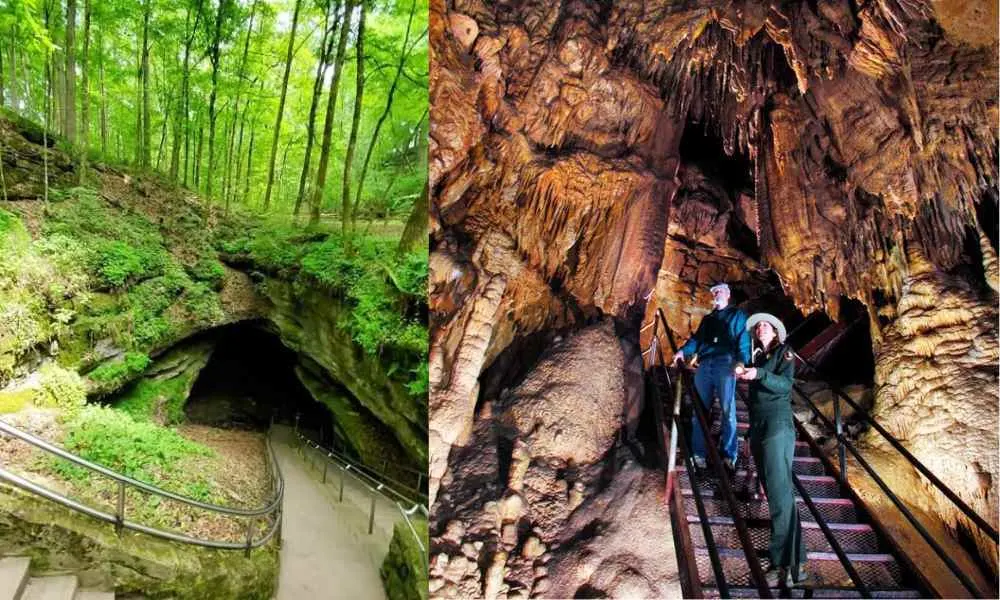14 Facts about Mammoth Cave, Kentucky, You Probably Didn’t Know
Mammoth Cave National Park, Kentucky, is known for being the world’s largest and longest known cave system. It spreads 426 miles of long passageways, and the National Park spreads over 52,830 acres. Mammoth cave is not just a cave system. It has vary ecological systems and ancient history. Before 4000 years ago, this place was home to giant mammoths that once ruled the earth, and that is the reason this place got called a Mammoth cave. As of today, the remains of mammoths can still be found in the cave system. Geologically, it is believed that the Mammoth Cave was formed by the dissolution of limestone and other sedimentary rocks, and underground water flow forms the passageways. Because of the geological and ecological specialty of the cave system and National Park, this was named an international biosphere reserve and designated as a UNESCO World Heritage Site.
According to statistics, Mammoth Cave is visited by more than 2 million visitors every year. The Park’s topography varies from the highest point at Brooks Knob, standing at 852 feet, to the lowest point along the Green River near Brownsville, measuring at 411 feet. The Mammoth Cave weather mostly experiences a moderate climate, characterized by warm and humid conditions, with mild winters and warm summers. So, let’s uncover some historical and unusual facts about Mammoth Cave.
1. It was an accident that found Mammoth Cave.
The most interesting fact about Mammoth Cave is Legend says that Mammoth Cave’s discovery was an accident. Legend says the cave was found by a young hunter named John Houchin. Jhon was chasing a wounded bear into the cave’s entrance in 1797. Although this story has a touch of fiction, it is etched in the cave’s lore. A cave section, “Houchin’s Narrows,” commemorates this legendary tale. The twilight zone, where sunlight filters into the entrance, creates a surreal ambiance along this path.
While John Houchin’s bear-chasing escapade is now considered a legend, it reflects the allure and mystery that Mammoth Cave held for early settlers. The cave’s vastness and inaccessibility fascinated many, and it wouldn’t be long before it played a surprising role in American history.
2. Human groups Lived In this Mammoth Cave Area.
The most intriguing fact about the Mammoth Cave is that there is evidence that Humans lived in and around the area. The history of Mammoth Cave stretches back thousands of years, with proof of human habitation dating as far back as 12,000 years ago. Native American groups were among the first to appreciate the unique qualities of this underground world.
Archaeological studies have shown a rich tapestry of Native American cultures that once thrived in the area. These groups, including the River People, Kentucky Cliff Dwellers, Mound Builders, and the Mammoth Cave Indians, left their mark deep within the cave’s passages. What is truly surprising is the extent to which these Native Americans ventured into the cave system. Unlike other prehistoric groups, the people of Mammoth Cave explored its depths extensively. They navigated through the intricate network of tunnels, leaving traces of their existence in textiles, pottery, woven sandals, and other artifacts.

3. It was part of The War Of 1812
Another fact about Mammoth Cave is it played a pivotal role in the War of 1812, the Second War of American Independence. The conflict pitted Britain against the United States, and England’s embargo on nitrate supplies posed a significant challenge for the U.S. Nitrates were a crucial component for producing gunpowder, essential for the war effort.
With its rich nitrate deposits, Mammoth Cave became a vital source for gunpowder production. The presence of this valuable material caused the value of Mammoth Cave to skyrocket. On July 9, 1812, ownership of the cave area changed hands multiple times, and its worth increased from a mere $116.67 to a staggering $3,000.

4. The Man Who Made Mammoth Cave Popular
In 1838, the cave’s popularity soared thanks to a teenager named Stephen Bishop, who brought to the cave by his owner, Franklin Gorin. Using ropes and flickering lanterns, Bishop’s daring explorations unveiled the cave’s hidden wonders. He pioneered in the truest sense, venturing into the unknown and mapping intricate tunnels.
Bishop’s exploration faced numerous challenges, including the complex honeycomb of sinkholes, cracks, fissures, boulders, domes, and underwater springs. A blown-out lantern could mean isolation in profound darkness and silence, with the threat of becoming permanently lost very real. It’s, therefore, hard to overstate Bishop’s influence. Some branches he explored didn’t find again until modern equipment was invented. The map he created from his memory of the cave served as a guide for generations of explorers and adventurers.

5. The legacy of the Bransford family
The legacy of enslaved individuals like Stephen Bishop continues to shape Mammoth Cave’s history. The Bransford family, including Mat and Nick Bransford, served as guides for over a century. The tradition endured through generations, with Jerry Bransford becoming an interpretive ranger and sharing his family’s remarkable connection to the cave with visitors.
Jerry Bransford’s story is a testament to the enduring legacy of those who contributed to Mammoth Cave’s exploration and popularity. Born and raised near the cave, Jerry’s family history deeply intertwined with the cave’s history. His work as an interpretive ranger allows him to bridge the past and present, connecting visitors to the incredible journey of his ancestors and the cave’s remarkable heritage.
6. UNESCO World Heritage Site
Mammoth Cave’s exceptional value earned it the prestigious designation of a UNESCO World Heritage Site in 1981. This recognition highlights the cave’s cultural, historical, and scientific significance, safeguarding it for future generations to cherish.
As a UNESCO World Heritage Site, Mammoth Cave is a testament to the extraordinary geological processes that shaped it and the rich history of exploration and human interaction with this underground world. It is a place where the past and present intersect, offering a window into Earth’s geological history and the enduring connection between humans and nature.
7. Mammoth Cave is The World’s Largest Cave System | How big is Mammoth Cave?
The most fascinating fact about Mammoth Cave is that it is the world’s largest cave system. With over 400 miles explored and the potential for another 600 miles within its system, it’s an underground labyrinth of unparalleled proportions. The cave’s vastness was further highlighted by significant cave connections in the 1950s and ’60s, culminating in the monumental 1972 connection.
The first significant connection occurred in 1955 when Crystal Cave joined Unknown Cave. Five years later, in 1960, Salts Cave connected to Colossal Cave, and in 1961, Salts Cave linked to Unknown Cave. This momentous achievement meant that all four caves—Crystal, Unknown, Colossal, and Salts—were interconnected and collectively referred to as the Flint Ridge Cave System.

8. Not only the largest, also the Longest Cave System In The World
Mammoth Cave stands as the world’s longest cave system, comprising over 400 miles of underground passageways.
On September 9, 1972, a team of six people embarked on a historic journey into the Austin Entrance on the Flint Ridge side of the valley in Mammoth Cave National Park. After traversing the cave for 12 hours, they reached Hanson’s Lost River, where they believed a connection to the Flint Ridge Cave System existed. Their relentless exploration led to the long-awaited link, forming 144.4 miles of cave passages.
This achievement solidified Mammoth Cave’s status as the longest-known cave in the world. The latest updates have extended the length of the cave to a whopping 426 miles.
9. Mammoth Cave Is Also An International Biosphere
In 1990, Mammoth Cave National Park achieved the status of an International Biosphere Reserve. This distinction signifies its role as a ‘learning place for sustainable development. As an International Biosphere Reserve, Mammoth Cave serves as a living laboratory. The researchers and conservationists can collaborate to study and protect the park’s ecosystems. It provides valuable insights into how humans can coexist harmoniously with nature.
10. Wide Variety Of Wildlife
Beyond its enchanting underground world, Mammoth Cave National Park is a thriving ecosystem. The park hosts diverse wildlife, including birds, crustaceans, fish, insects, mammals, mussels, plants, and reptiles. Over 70 species are classified as threatened, endangered, or state-listed, underscoring the park’s vital role in conservation.
The lush forests, pristine waterways, and intricate cave systems provide a rich habitat for many species. Birdwatchers can delight in the sight of various avian residents. The park’s commitment to protecting these species ensures the continued survival of these remarkable creatures.
11. Blind Or Eyeless Animals in the Mammoth Cave
Disturbing and scary facts about Mammoth Cave are depths conceal a realm of eyeless creatures adapted to perpetual darkness. These remarkable organisms have evolved over generations to thrive in an environment devoid of light. One of the most iconic residents of this underground world is the Mammoth Cave Blindfish. It discovered around 1888 in Echo River.
In addition to the Blindfish, more than 100 species of blind or eyeless animals have been documented within the cave’s labyrinthine passages. These include crawfish, beetles, spiders, snails, and worms. Their adaptations to complete darkness are nothing short of extraordinary, a testament to the tenacity of life in the most challenging of environments.

12. A Wide Variety Of Plant Species
A fascinating fact about Mammoth Cave for tree lovers is that Mammoth Cave boasts a rich tapestry of plant life. The convergence of the Green and the Nolin rivers nourishes the park’s soil, fostering a wide array of flora. As visitors explore the park’s diverse landscapes, they can encounter over 100 different types of trees, shrubs, ferns, and flowers.
The changing seasons bring a kaleidoscope of colors and scents to the park. Along the trails and river bluffs, several hundred species of flowers bloom from early spring to late fall. Thirty-one varieties of ferns add a touch of lush greenery to the landscape. The forested areas are primarily deciduous. But some pines, cedars, and other evergreens punctuate the scenery, creating a rich mosaic of plant life.
13. Kentucky Cave Shrimp
Another Mammoth Cave National Park Facts concerns the Kentucky Cave Shrimp. According to the National Park Service, the Kentucky cave shrimp (Palaemonius ganteri) found only near Mammoth Cave National Park. It federally endangered, fully cave-adapted freshwater shrimp.
First described by W.P. Hay in 1901, these shrimp inhabit the lowest-level cave passages in ten groundwater basins. Eight of these basins lie wholly or partially in the park and two lie just upstream from the park. The designated critical habitat for Kentucky cave shrimp is the Roaring River in Mammoth Cave. Fish and Wildlife Service (USFWS), is responsible for ensuring the survival of this extraordinary species.

14. There was a Tuberculosis Hospital Built Inside a Cave
Inside Mammoth Cave, there used to be a tuberculosis hospital like no other. Patients with tuberculosis lived in small wooden cottages built about a mile and a half inside the cave’s entrance. These cottages were not very big, measuring just 12 by 18 feet, and had simple canvas roofs. Inside were stoves and thermometers so patients could ensure the temperature was just right. The doctors believed that cooler air was healthier, so they told patients to keep it as cold as they could handle. Dr. John Croghan designed this unique experiment, and he described the community as having a “picturesque, yet at the same time, a gloomy and mournful appearance.”

Despite the darkness of the cave, patients adjust to their new homes. They lit the cave with stearin lamps during the day and used taper candles at night. The patients filled their time by exploring the cave, chatting with each other, and reading books. They even attended Episcopal services on Sundays and read sermons. Slaves brought in meals and often included venison. This fascinating historical experiment took place in the 19th century.

What is Mammoth Cave | Basic facts about Mammoth Cave
Mammoth Cave National Park is nestled in central Kentucky and boasts an impressive distinction. It is home to the world-known cave system, with a staggering 400 miles of underground passageways. The park derives its name from the remnants of ancient mammoths discovered within the cave, bearing witness to a time long past.
This cave system is a mesmerizing network of underground tunnels, chambers, and passages formed over eons. Its unique geology showcases stalactites, stalagmites, and other awe-inspiring formations. These formations result from a complex interplay between water, minerals, and time. Stalactites hang like icicles from the cave’s ceiling, while stalagmites grow from the cave floor, creating surreal landscapes that have drawn visitors for centuries.

Conclusion
Mammoth Cave Kentucky is not merely a cave. It’s a testament to the awe-inspiring power of nature and the indomitable human spirit. Its rich history, geological wonders, and vibrant ecosystems continue to captivate explorers, scientists, and visitors worldwide. As we delve deeper into the mysteries of this underground cave, we discover that Mammoth Cave is not just a place frozen in time; it’s a living testament to the interconnectedness of Earth’s geology and the enduring legacy of human exploration and conservation.
Also read:







